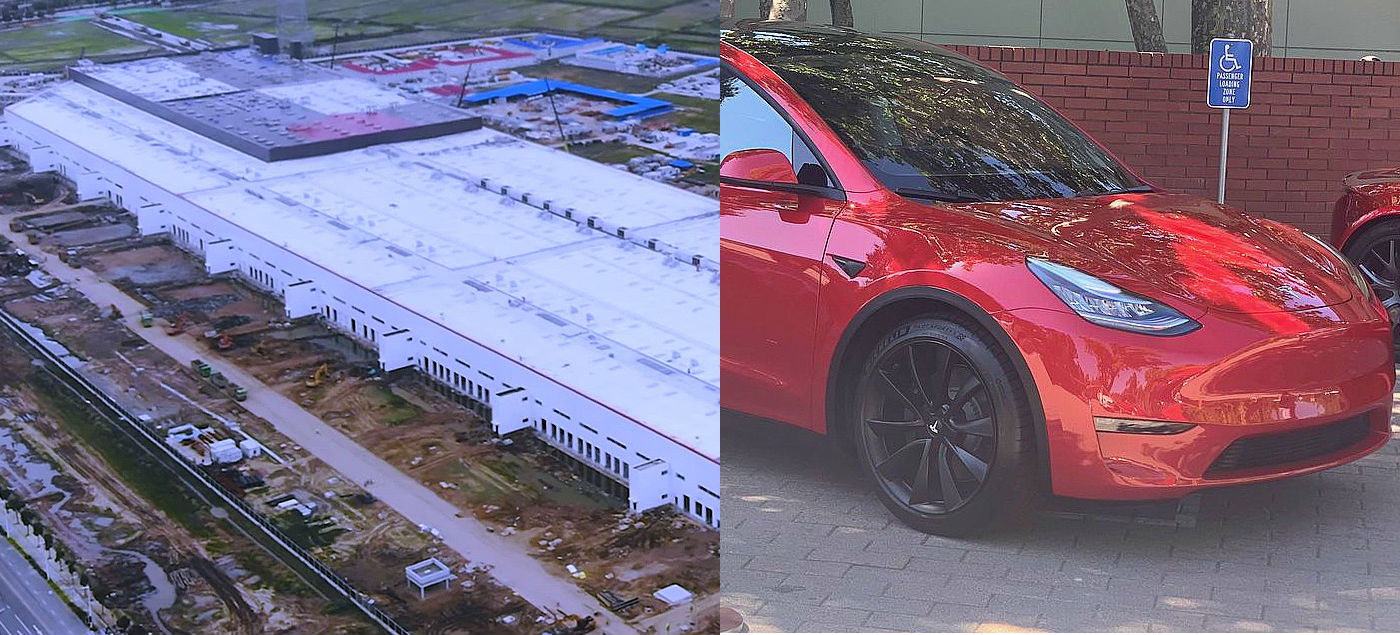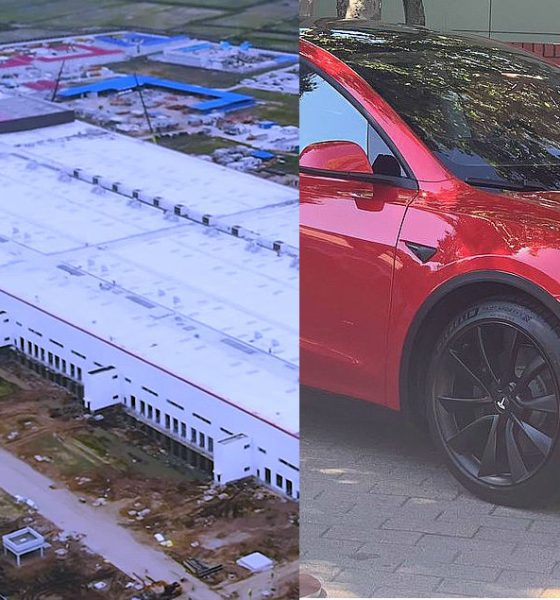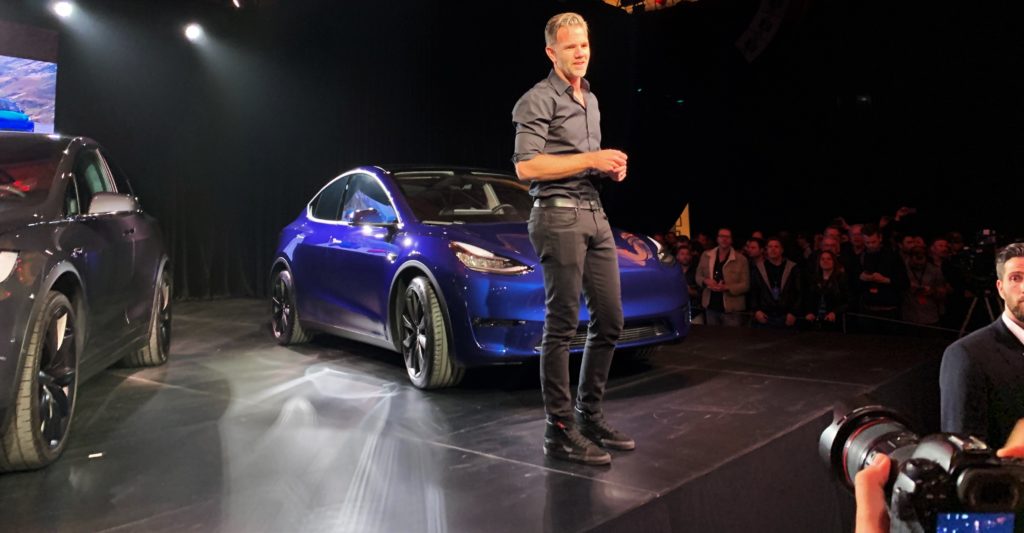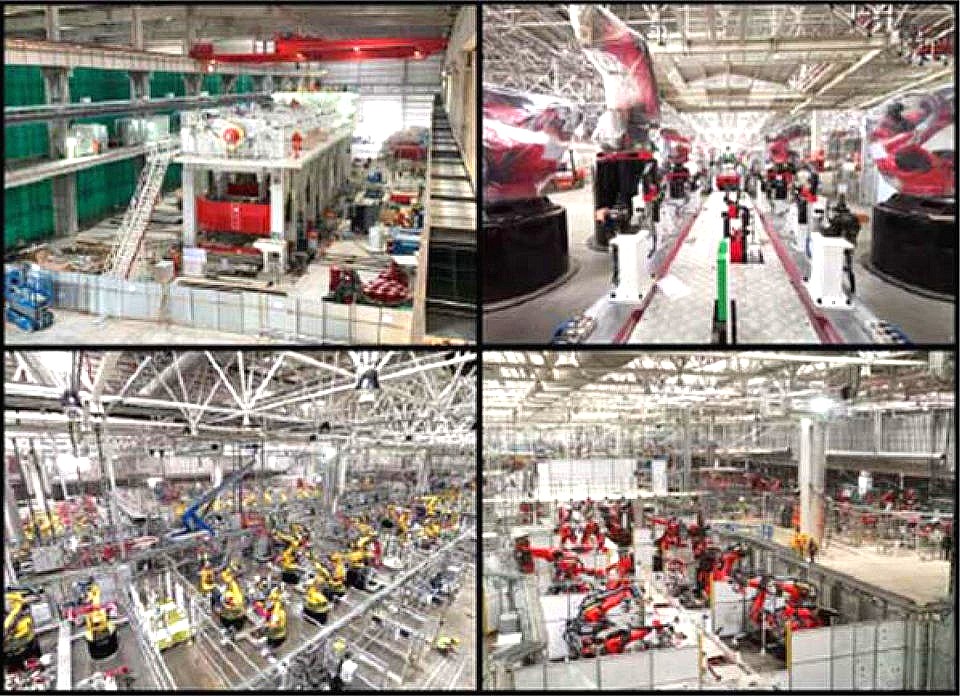

News
The Model Y and Gigafactory 3 heralds a faster, more profitable Tesla
Tesla’s second-quarter report and its succeeding earnings call provided updates on what could very well be two of the electric car maker’s most pertinent projects to date: the Model Y ramp and Gigafactory 3 in Shanghai, China. Based on Tesla’s recent reports, it appears that both initiatives are moving along at an impressive pace, perhaps even faster than initially expected.
Model Y
When Elon Musk unveiled the Model Y last March, he provided a rough timeline for the upcoming vehicle. During his presentation, Musk mentioned that the all-electric midsize SUV would start deliveries starting Fall 2020 for the Long Range, Dual Motor AWD, and Performance versions, and Spring 2021 for the Standard variant. This was quite conservative, considering that Musk has a reputation for setting extremely aggressive targets for the production of the company’s vehicles.
Since then, several reports have emerged which hinted at Model Y production being far less volatile and challenging than the Model 3’s manufacturing ramp, a task so difficult that Elon Musk candidly called the period as “production hell.” In the Q2 Update Letter, Tesla confirmed that preparations for Model Y production have begun in the Fremont factory. The company also mentioned that due to the overlap in the components of the Model Y and the Model 3, the company was able to “leverage existing manufacturing designs in the development of the Model Y production facilities.” This bodes well for the midsize SUV, considering that Tesla had rolled out several improvements to Model 3 production process over the years.

Several other hints have also emerged suggesting that Tesla will be ramping the Model Y with its best technologies available. Recent patent applications, for example, have revealed that Tesla is working on a new wiring architecture that will reduce the wires used in the Model Y to just 100 m per vehicle, a significant reduction from the 1.5 km currently being used for the Model 3. Another patent has also emerged showing the design for a mammoth casting machine, which was hinted at by Elon Musk during an appearance at the Ride the Lightning podcast last month. “When we get the big casting machine, it’ll go from 70 parts to 1 with a significant reduction in capital expenditure on all the robots to put those parts together,” Musk said.
Considering all the innovation that is being implemented for the Model Y, it appears that Tesla is doing all it can to ensure that the vehicle does not encounter delays with its rollout. In fact, with Fremont already being prepared for the Model Y, and with giant casting machines being designed specifically for the vehicle, it almost seems like Tesla is trying to start the manufacturing of the SUV earlier than expected. There’s a long time between today and Fall 2020, and that seems to be more than enough to work out the manufacturing of a vehicle that is, in essence, a taller, more spacious Model 3.
Gigafactory 3
Over in China, another understated Tesla project is taking shape. When Elon Musk attended Gigafactory 3’s groundbreaking ceremony back in January, he stated that initial production of the Model 3 in the facility would begin by the end of the year. This target timeframe was met with disdain and skepticism from critics, many of whom have noted that no car factory has ever been built in the speed that Musk wanted. Six months later, Gigafactory 3’s general assembly building is practically complete, and its interior is already being tooled. Footage from drone flyovers showed the rise of the factory, and images from Tesla’s Q2 Update Letter showed that some sections of the facility already have robots installed in them.

Quite interestingly, it is not Elon Musk that is providing ambitious timeframes for Gigafactory 3 anymore. Instead, it is Chinese government officials. Local reports, for example, have suggested that China is looking to start initial Model 3 production as early as September, with the facility ramping to an output of 150,000 vehicles per year early next year. Compared to Wall Street’s estimates, which currently suggest that Gigafactory 3 will produce around 35,000 to 40,000 vehicles in 2020, China’s goals for the facility are far more optimistic.
Gigafactory 3 has pretty much exceeded expectations since work in the facility entered overdrive. Just like the Model Y ramp, the key to Gigafactory 3 lies in the company’s innovations with Model 3 production. Tesla mentioned this in its Q2 Update Letter. “Gigafactory Shanghai continues to take shape, and in Q2 we started to move machinery into the facility for the first phase of production there. This will be a simplified, more cost-effective version of our Model 3 line with capacity of 150,000 units per year – the second generation of the Model 3 production process,” Tesla wrote.
There is no doubt that 2019 is turning out to be an incredibly challenging year for Tesla. Following the first quarter, which saw lower-than-expected vehicle deliveries, Tesla set new delivery records in the second quarter, only to end once more at a loss. Yet, together with this, the company also ended the quarter in more stable footing, as shown by its $5 billion in cash, the largest in its history. This was recently addressed by Baird analyst Ben Kallo, who noted that “back to the cash flow they generated during the quarter, there’s a couple of hundred million dollars, so this idea that they don’t make money is completely wrong, and the headline needs to change. There’s $5 billion in the balance sheet. They’re not going out of business.” Ultimately, the Model Y and Gigafactory 3 seem to be two projects that are heralding a new era for Tesla: one that is more mature, precise, and poised to disrupt at a scale that’s never seen before.

News
I subscribed to Tesla Full Self-Driving after four free months: here’s why
It has been incredibly valuable to me, and that is what my main factor was in considering whether to subscribe or not. It has made driving much less stressful and much more enjoyable.

I have been lucky enough to experience Tesla Full Self-Driving for the entire duration of my ownership experience for free — for four months, I have not had to pay for what I feel is the best semi-autonomous driving suite on the market.
Today, my free trial finally ran out, and I had two choices: I could go without it for a period until I felt like I absolutely needed it, or I could subscribe to it, pay $99 per month, and continue to experience the future of passenger transportation.
I chose the latter, here’s why.
Tesla Full Self-Driving Takes the Stress Out of Driving
There are a handful of driving situations that I don’t really enjoy, and I think we all have certain situations that we would just rather not encounter. This is not to say that I won’t ever experience them as someone who has driven a car for 15 years (it feels weird saying that).
I don’t love to drive in cities; I really don’t like driving on I-695 on my way to Baltimore, and I truly hate parallel parking. All three things I can do and have done, all three within the past few weeks, too.
It takes all the stress out of city driving pic.twitter.com/q0SPPrH4HU
— TESLARATI (@Teslarati) December 4, 2025
However, if I can avoid them, I will, and Tesla Full Self-Driving does that for me.
Tesla Full Self-Driving Eliminates the Monotony
I drive to my alma mater, Penn State University, frequently in the Winter as I am a season ticket holder to Wrestling and have been for 16 years now.
The drive to State College is over two hours and over 100 miles in total, and the vast majority of it is boring as I travel on Rt 322, which is straight, and there is a lot of nature to look at on the way.
I am willing to let the car drive me on that ride, especially considering it is usually very low traffic, and the vast majority of it is spent on the highway.
The drive, along with several others, is simply a boring ride, where I’d much rather be looking out the windshield and windows at the mountains. I still pay attention, but having the car perform the turns and speed control makes the drive more enjoyable.
Tesla Full Self-Driving Makes Navigating Easier
Other than the local routes that I routinely travel and know like the back of my hand, I’ve really enjoyed Full Self-Driving’s ability to get me to places — specifically new ones — without me having to constantly check back at the Navigation.
Admittedly, I’ve had some qualms with the Nav, especially with some routing and the lack of ability to choose a specific route after starting a drive. For example, it takes a very interesting route to my local Supercharger, one that nobody local to my area would consider.
But there are many times I will go to a new palce and I’m not exactly sure where to go or how to get there. The Navigation, of course, helps with that. However, it is really a luxury to have my car do it for me.
To Conclude
There was no doubt in my mind that when my Full Self-Driving trial was up, I’d be subscribing. It was really a no-brainer. I am more than aware that Full Self-Driving is far from perfect, but it is, without any doubt, the best thing about my Tesla, to me.
It has been incredibly valuable to me, and that is what my main factor was in considering whether to subscribe or not. It has made driving much less stressful and much more enjoyable.
🚨 How I’ve gotten Tesla Full Self-Driving for free…until now
Watch me subscribe to Tesla FSD! https://t.co/bjK7EEOptR pic.twitter.com/cs5CmN5PdJ
— TESLARATI (@Teslarati) January 7, 2026
News
Tesla Diner becomes latest target of gloom and doom narrative

The Tesla Diner has been subject to many points of criticism since its launch in mid-2025, and skeptics and disbelievers claim the company’s latest novel concept is on its way down, but there’s a lot of evidence to state that is not the case.
The piece cites anecdotal evidence like empty parking lots, more staff than customers during a December visit, removed novelty items, like Optimus robot popcorn service and certain menu items, the departure of celebrity chef Eric Greenspan in November 2025, slow service, high prices, and a shift in recent Google/Yelp reviews toward disappointment.
The piece frames this as part of broader Tesla struggles, including sales figures and Elon Musk’s polarizing image, calling it a failed branding exercise rather than a sustainable restaurant.
This narrative is overstated and sensationalized, and is a good representation of coverage on Tesla by today’s media.
Novelty Fade is Normal, Not Failure
Any hyped launch, especially a unique Tesla-branded destination blending dining, Supercharging, and a drive-in theater, naturally sees initial crowds taper off after the “Instagram effect” wears down.
Tesla makes major change at Supercharger Diner amid epic demand
This is common for experiential spots in Los Angeles, especially pop-up attractions or celebrity-backed venues. The article admits early success with massive lines and social media buzz, but treats the return to normal operations as “dying down.”
In reality, this stabilization is a healthy sign of transitioning from hype-driven traffic to steady patronage.
Actual Performance Metrics Contradict “Ghost Town” Claims
- In Q4 2025, the Diner generated over $1 million in revenue, exceeding the average McDonald’s location
- It sold over 30,000 burgers and 83,000 fries in that quarter alone. These figures indicate a strong ongoing business, especially for a single-location prototype focused on enhancing Supercharger experiences rather than competing as a mass-market chain
It’s not a ghost town lol. The @Tesla Diner still had over 30,000 burger orders and 83,000 fries orders in Q4. The diner generated over $1M in revenue in Q4, a $4M annual run rate, which is more than the average McDonald’s…. pic.twitter.com/XvAGLUqxej
— Sawyer Merritt (@SawyerMerritt) January 4, 2026
Conflicting On-the-Ground Reports
While the article, and other similar pieces, describe a half-full parking lot and sparse customers during specific off-peak visits, other recent accounts push back:
- A January 2026 X post noted 50 of 80 Supercharger stalls were busy at 11 a.m., calling it “the busiest diner in Hollywood by close to an order of magnitude
TESLA DINER 🍔
Frantic!!!
Crazy busy. pic.twitter.com/wMbmr8SFFn
— Rich & Sharon (@HullTeslaModel3) January 4, 2026
- Reddit discussions around the same time describe it as not empty when locals drive by regularly, with some calling the empty narrative “disingenuous anti-Tesla slop.”
When we visited it last week it was packed. We had to wait to enter, get a table and go to the restroom. We were lucky to find a spot to charge.
— Rani G (@ranig) January 4, 2026
Bottom Line
The Tesla Diner, admittedly, is not the nonstop circus it was at launch–that was never sustainable or intended. But, it’s far from “dying” or an “empty pit stop.”
It functions as a successful prototype: boosting Supercharger usage, generating solid revenue, and serving as a branded amenity in the high-traffic EV market of Los Angeles.
News
Tesla stands to win big from potential adjustment to autonomous vehicle limitations
Enabling scale, innovation, and profitability in a sector that is growing quickly would benefit Tesla significantly, especially as it has established itself as a leader.

Tesla stands to be a big winner from a potential easing of limitations on autonomous vehicle development, as the United States government could back off from the restrictions placed on companies developing self-driving car programs.
The U.S. House Energy and Commerce subcommittee will hold a hearing later this month that will aim to accelerate the deployment of autonomous vehicles. There are several key proposals that could impact the development of self-driving cars and potentially accelerate the deployment of this technology across the country.
These key proposals include raising the NHTSA’s exemption cap from 2,500 to 90,000 vehicles per year per automaker, preempting state-level regulations on autonomous vehicle systems, and mandating NHTSA guidelines for calibrating advanced driver assistance systems (ADAS).
Congress, to this point, has been divided on AV rules, with past bills like the 2017 House-passed measure stalling in the Senate. Recent pushes come from automakers urging the Trump administration to act faster amid competition from Chinese companies.
Companies like Tesla, who launched a Robotaxi service in Austin and the Bay Area last year, and Alphabet’s Waymo are highlighted as potential beneficiaries from lighter sanctions on AV development.
The NHTSA recently pledged to adopt a quicker exemption review for autonomous vehicle companies, and supporters of self-driving tech argue this will boost U.S. innovation, while critics are concerned about safety and job risks.
How Tesla Could Benefit from the Proposed Legislation
Tesla, under CEO Elon Musk’s leadership, has positioned itself as a pioneer in autonomous driving technology with its Full Self-Driving software and ambitious Robotaxi plans, including the Cybercab, which was unveiled in late 2024.
The draft legislation under consideration by the U.S. House subcommittee could provide Tesla with significant advantages, potentially transforming its operational and financial landscape.
NHTSA Exemption Cap Increase
First, the proposed increase in the NHTSA exemption cap from 2,500 to 90,000 vehicles annually would allow Tesla to scale up development dramatically.
Currently, regulatory hurdles limit how many fully autonomous vehicles can hit the roads without exhaustive approvals. For Tesla, this means accelerating the rollout of its robotaxi fleet, which Musk envisions as a network of millions of vehicles generating recurring revenue through ride-hailing. With Tesla’s vast existing fleet of over 6 million vehicles equipped with FSD hardware, a higher cap could enable rapid conversion and deployment, turning parked cars into profit centers overnight.
Preempting State Regulations
A united Federal framework would be created if it could preempt State regulations, eliminating the patchwork of rules that currently complicate interstate operations. Tesla has faced scrutiny and restrictions in states like California, especially as it has faced harsh criticism through imposed testing limits.
A federal override of State-level rules would reduce legal battles, compliance costs, and delays, allowing Tesla to expand services nationwide more seamlessly.
This is crucial for Tesla’s growth strategy, as it operates in multiple markets and aims for a coast-to-coast Robotaxi network, competing directly with Waymo’s city-specific expansions.
Bringing Safety Standards to the Present Day
Innovation in the passenger transportation sector has continued to outpace both State and Federal-level legislation, which has caused a lag in the development of many things, most notably, self-driving technology.
Updating these outdated safety standards, especially waiving requirements for steering wheels or mirrors, directly benefits Tesla’s innovative designs. Tesla wanted to ship Cybertruck without side mirrors, but Federal regulations required the company to equip the pickup with them.
Cybercab is also planned to be released without a steering wheel or pedals, and is tailored for full autonomy, but current rules would mandate human-ready features.
Streamlined NHTSA reviews would further expedite approvals, addressing Tesla’s complaints about bureaucratic slowdowns. In a letter written in June to the Trump Administration, automakers, including Tesla, urged faster action, and this legislation could deliver it.
In Summary
This legislation represents a potential regulatory tailwind for Tesla, but it still relies on the government to put forth action to make things easier from a regulatory perspective. Enabling scale, innovation, and profitability in a sector that is growing quickly would benefit Tesla significantly, especially as it has established itself as a leader.








